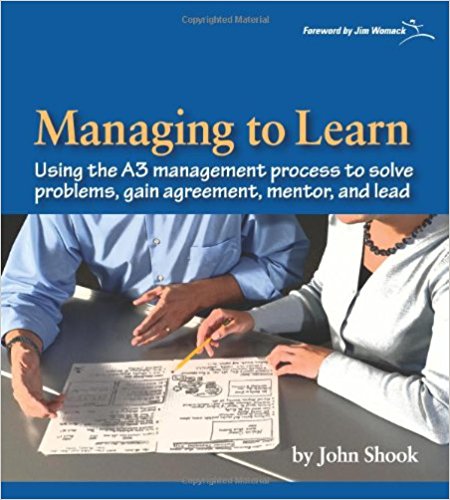Managing to Learn Summary

3 min read ⌚
 Using the A3 Management Process to Solve Problems, Gain Agreement, Mentor and Lead
Using the A3 Management Process to Solve Problems, Gain Agreement, Mentor and Lead
Tired of being the underdog? Gain strength by understanding what is keeping you down with the aid of the A3 Management system.
“Managing to Learn” unveils many techniques that can be used in various situations to find the problem.
About John Shook
 John Shook is best described as an industrial anthropologist who places faith in lean production laws and methods.
John Shook is best described as an industrial anthropologist who places faith in lean production laws and methods.
“Managing to Learn Summary”
A3 is a process that is designed to help managers and other individuals solve problems and conduct strategic planning. The A3 method is not randomly constructed. With a template to act as guidance, you will be given an opportunity to enforced “standardized storytelling.”
In the first place, you must encapsulate all the issues, which describe the comprehensive story.
John Shook puts no stock in conservative thinking, and as a Toyota insider, he appeals to all the people to follow their dreams. Bring your yearnings one step closer to you, with the support of A3 management thinking patterns.
Put your ideas to the test and embark on a full-scale problem-solving campaign.
Every A3 use case or process acts in accordance with a structure consisting of several fundamental elements:
“Title” – How to classify the problem that is causing a lot of trouble?
“Background” – What is this in reference to?
“Current conditions” – Are you familiar with the problem and the burden emerging from it?
“Goals and targets” – What is the desired outcome and are your strivings complementary to reality?
“Analysis” – What caused the situation or issues?
“Proposed countermeasures” – What actions do you think are best fitting for the current circumstances?
“Plan” – According to your understanding, how should you conduct the delegation process?
“Follow up” – When is it appropriate to review the A3 progress?
Identify potential blockades of the processes
Every story starts with a problem, and after the culmination, it must end with a solution – that’s the untold order. Begin by defining a clear and concise title that gives further explanation of the issue. In the hope that all the disputed points will be put to sleep, one must follow and launch the problem-solving process.
Going to the physical location of the situation that is causing trouble is what the Japanese call – “gemba.”
Investigating all the components involved in the process can be challenging. The A3 analysis doesn’t give a clear distinction between the actual issue and its symptoms. Be on a full alert and resist the temptation to jump into conclusion. Subdue every explosive instinct and take the process one step at a time.
Five Whys is the greatest ally in the root-cause examination system. Using the “Why” on a repetitious basis will improve your chances of understanding the core of the problem. Enforcing such practice matches the ability to dig deep and discover what has been causing disorder and mess.
Conducting a perfect allocation of resources is an unrealistic scenario. However, sharing the responsibilities with your team in pursuit of getting the technique right, is something you should pay attention to. Finalize the plan but make sure all the member are present while you are making the final preparations.
Even though, your A3 template may seem perfect; you are far from over. Choosing your steps wisely signifies the capacity of your organization to implementing countermeasures when things get rough. Reviewing your PDCA (Plan, Do Check, Act) cycle is critical.
Think twice before you make the final call. Becoming more secure with the A3 thinking-method illustrates your strivings to grow in all areas.
Like this summary? We’d Like to invite you to download our free 12 min app, for more amazing summaries and audiobooks.
“Managing to Learn” Quotes
A story is more than lifeless data to prove a point. It brings the facts and the total reality of the condition to life so the reader can understand and debate the true nature of the situation. Share on X The A3 is the instrument enabling the right decision at the right time. Share on X Like any narrative tale, an A3 shares a complete story. Share on X Real improvement only can take place when there is a frontline focus based on direct observation of current conditions where work is done. Share on X Lean management is neither a simple top-down nor bottom-up process. Rather, it is a dynamic system in which processes are well-defined and individual responsibility is clear. Share on X







